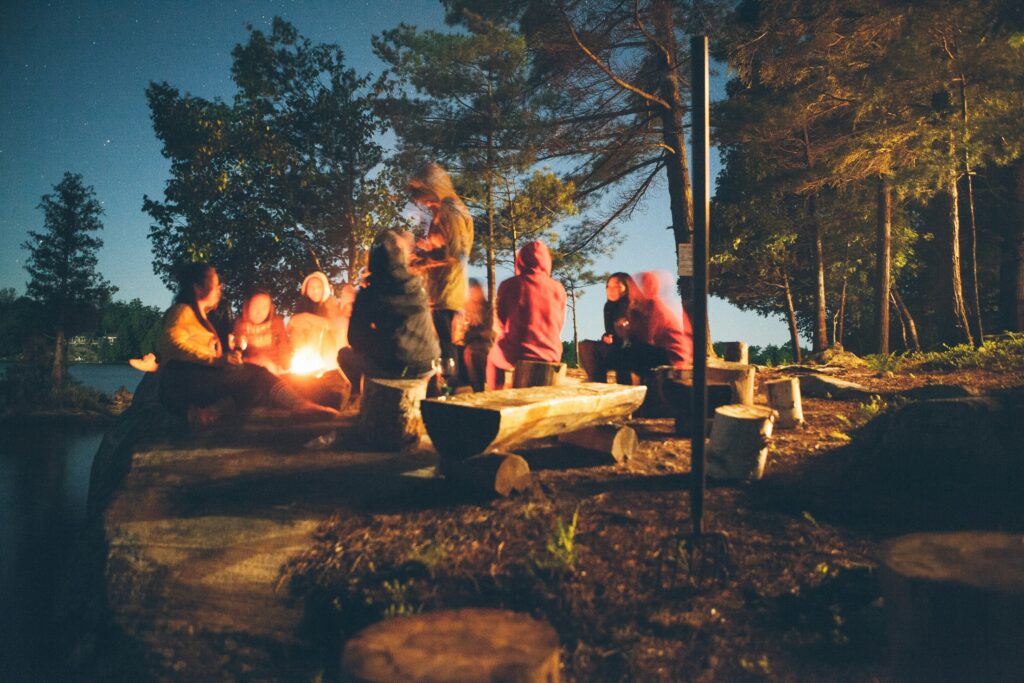“We can’t find the Blob.”
“What?! It’s gigantic! What do you mean, ‘we can’t find the Blob’?”
“I dunno…” shrug. “At least…it’s not where you said it would be.”
“Sure it is. It’s next to the pool house under the –”
“Found it!” your radio shouts, interrupting your conversation with the new waterfront staff. “It’s behind the maintenance shed. But it’s really gross…and I think it has a hole in it.”
You have a flashback to last year as the clock ran out on your final day of camp. An exasperated version of yourself told a group of struggling staff to haul a punctured blob to maintenance and that “you’d take care of it.” Oops.
You glance at your training week to-do list. ‘Set up Blob’ just became ‘find and repair hole’ plus ‘pressure wash Blob’. No sweat…except you’re already behind schedule. The infomercial that you stress-watched last night comes to mind. You now feel a strange connection to the woman who, struggling to cut a cucumber, declared, “There’s got to be a better way.”
Where do we start?
There is a better way… it started a year ago when you told that group, “I’ll take care of it”. There is an effective way to start up the camp season, and it starts with shutting down well at the end of last year. Every seasoned director has horror stories of discovering key program logistics that have gone missing or are broken mere days before camp is slated to begin. It’s a recipe that can create a legend…or burn someone out before they get off the starting blocks. Why risk it?
Shutting down camp is an enormous task, and it comes at a time when staff are running on fumes. A successful start is found in ending the current season well, the process begins before you’re fishing a Blob out of the lake.
To be fair, an effective and efficient shutdown process takes time and practice to build. Each facility and camp is different. The amount of work to be done, as well as the resources available to do it, vary widely. As you go about building out your shutdown sequence, here are five factors to keep in mind.

Level 1: Clean, Organize, Secure
The essence of shutting down camp begins with ensuring every area is at least three things: clean, organized, and secure. Even in your zombie-like state, you can start pointing at activities, vehicles, and buildings with instructions to clean, organize, and secure them. As in, “Ok, the next thing is to clean, organize, and secure the craft building.” “Great job! Next, please clean, organize, and secure all the boats.” “Thanks so much! Head over to clean, organize, and secure the pool area.”
Will there be some specific questions along the way? Sure. But many of your staff will solve the details of this process on their own. You may be surprised to find how effective it is for your entire team to understand your overall picture of success. It might take extra effort now, but patching that hole and correctly folding/rolling up the Blob will pay dividends at the beginning of next season. Consider paying a small group to stay behind for a few extra days to ensure things get done right.
Getting a clear picture and purpose for your team is easier than you think. Brief them a week or two before camp ends so that they can be ready to finish strong and not mentally check out when the last campers are gone.
Level Two: Inventory
How many arrows survived the summer? How many pounds of chlorine are sitting in the pumphouse at the pool? Do any of the ropes at the rock wall need to be replaced? Level two in an effective shutdown sequence is to have your team generate an accurate inventory for each department. Create a list showing remaining materials and highlighting logistical elements that need to be refilled or replaced.
Using a standardized process such as a webform questionnaire, your team can generate valuable inventory data. This takes them an hour or two. If you did it alone, you’re looking at at least a week of work. Comparing end-of-summer inventory levels to what you started with helps you make better budget decisions for next year.
Turn inventory data into a purchase list and put in orders as soon as the fiscal year turns over. This helps avoid disruption due to production or shipping delays, which have become normal for several random items. Use inventory information as a part of evaluating the season’s performance. If the crafts department ends the summer with 50% more materials than last year was either twice as efficient or twice as lazy.
Knowing what you’re ending this season with helps tell the story of your summer and make adjustments for next season. Yes, it’s more time. But it’s also more knowledge.

Level Three: Exit Interviews
Perhaps you’ve heard the phrase “You don’t get two chances to make a first impression”. How many chances do you get to make a last impression? For most, a last impression is also a lasting impression. What makes camp a positive, impactful, and often transformative experience that it is for campers is its staff. Cleaning is important, but connecting with each member of your team is the most critical element of ending the season.
GALLUP data suggests that about half of voluntary turnover is directly tied to relational health between employee and manager. Departing employees who experience a positive off-boarding process are nearly three times as likely to recommend the organization as those who leave through a neutral, negative, or no off-boarding process.
Fielding a quality team is one of the most difficult challenges of putting on a safe and meaningful camp season. Reducing turnover by 50% while tripling positive reviews from outgoing team members makes a difference. The difference between a recruiting season that lasts a few weeks and one that lasts a few months.
Debriefing with your team on an individual level is a source of transformative insights that help you build a better, more impactful program year after year. While you’re flying at 25,000 feet, staff have been on the ground taking notes about what is and isn’t working. Providing a chance to share their perspective with you legitimizes your claims about their value and generates insights that lead to meaningful change.
There are many right ways to conduct powerful exit interviews, but there are also some things to look out for. Waiting until the last minute, which forces you to rush the process, and opting for a safe, sterile process that avoids, or even punishes, honest feedback.
Level Four: Structure in Place
Chances are good that the last thing you want to think about at the end of a camp season is the structure of the next one. However, your workflow skills are sharpest right now, and a plan will save you time and energy later. This is also the time when the lessons you’ve learned from the current season can translate into helpful changes for the next go around, before either the information or the motivation dissipates.
Think in broad strokes: Do we want to run the same number of camp sessions in the same order? Did we notice something that could improve with our activity line-up or rotations? Are there any contracts that we already know we want to renew? Yes, you’re tired–like, really tired–but it won’t take a lot to get the core components in place. Hop online and set up the basics for next year’s registration (shameless plug for UltraCamp’s excellent software here) and call up vendors you rely on to quickly and easily renew for next season. Use the notes you took from your exit interview process to update core elements of your program so they are ready for review and implementation long before other pressures crowd them out and keep them from happening.
Most, if not all, of the above can be accomplished within 48 hours, but it comes at a time when energy can be extremely hard to come by. Left to will power alone, this critical step will get pushed down the road, but adding it to your shutdown sequence will ensure it gets done. Your present self might groan, but your future self just breathed a satisfied sigh of relief.

Level Five: Follow-up Communication
If it feels like it’s getting harder to hire and retain quality staff, that’s because it is. The emergence of the “gig economy” (on-demand services like food delivery or transportation) means more and more young people see work as a series of isolated one-off experiences rather than an ongoing pathway leading further into growth, competency, and career. Combined with the likely fact that your staff are bombarded with a variety of opportunities in-between camp seasons and it becomes increasingly clear that your ability to attract and retain quality staff relies on staying connected with your former staff in the off-season.
“Great,” you may be thinking with an internal sigh. “One more thing to add to the endless checklist.” But consider this: crafting a brief message of updates and encouragement and sending it to your staff roster takes 30 minutes or less. If sending out 4-6 messages in between seasons retains even just a few additional staff, the ROI on your time is worth it. Filling empty slots often means spending time advertising, traveling, interviewing, and vetting – and that assumes you have enough applicants. Retaining staff also reduces the amount of time and energy you put into onboarding new staff each year.
Don’t overthink it: a quick, positive message is all you need to stay connected. If you aren’t sure where to start, check out our staff retention download with sample messages. Set reminders in your calendar to ensure that messages are crafted and sent, and are included in wrapping up the camp season.
Shutting it down
Starting up the season doesn’t have to be the frenetic, whack-a-mole experience it often proves to be. Leaving your facility clean, organized, secured, and inventoried will save precious time and energy upon your return. Quality debriefs with each member of your team let them know they are valued and provide key insights for program growth and improvement. Setting up the basic architecture early locks in those improvements (also reducing stress down the road) and staying connected with your staff throughout the off-season increases the likelihood they will return and/or give positive reviews to other potential staff.
If we’re honest, the camp machine is never fully off. But winding down this camp season well makes it much easier to start the next one. It also ensures energy and focus toward having the kind of impact that keeps you coming back year after year.


